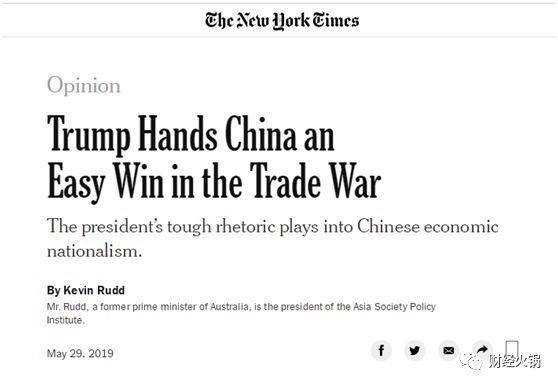陆克文:中国已不再软弱!
1919年的巴黎和会,作为第一次世界大战协约国的中国受辱,从而诱发了“五四运动”。100后,中国已不再软弱,冀望签定“不平等条约”让中国受屈,那是大错特错。
下文作者为澳大利亚前总理、纽约亚洲协会政策研究所主席陆克文:
当特朗普总统在5月5日发推宣布取消对华贸易协定时,中国的回应是响亮而清晰的。
几乎就在100年前,中国1919年的“五四运动”直接回应了第一次世界大战结束时伍德罗·威尔逊总统的行动:威尔逊违背了美国向其盟友中国的承诺,拒绝归还中国德国在山东的殖民地的主权,而是把山东交给了日本,并被日本将殖民地扩大了(小编注:也许是报应,1919年10月2日,威尔逊发作严重中风,导致左半边身子完全瘫痪,左眼失明),中国的反美民族主义情绪彻底爆发。随后,中国共产党成立,这100年来共产党领导着中国取得了举世瞩目的成就。
因此,特朗普给了中国一张非常有效的民族主义牌。中国的经济虽然放缓,但拥有着14亿人口的巨大消费力将是中国经济复苏的原动力,中国人民的爱国主义根本不需要号召,不管是长征,还是抗美援朝、对越自卫,共产党经历了许多艰辛,但最终都取得了胜利。
我几乎可以听到特朗普政府成员的呻吟。为什么他们会如此呢?
答案取决于特朗普先生的主要目标是什么。如果对美国选民来说听起来很难,他可能会有一个成功连任的方法。但是,如果要实现中国在双边贸易协议上的谈判态势发生实质性变化,那么可能会引发中国贸易政策的变化,包括美方提出的解决强迫技术转让,知识产权,工业补贴,货币和其他非关税壁垒,我不太确定。
在特朗普的推文发布几天后,中国列出了三条“红线”,即美国在贸易谈判中采取的不可接受的立场:第一,它将在拟议的贸易协定签署后一段时间内保持关税不变。第二,如果它判定中国违反了协议,就可以征收惩罚性关税,并禁止中国以自己的关税进行报复。第三,北京将根据拟议中的双边采购协议购买美国商品的条款,其预期越来越高。
这些“红线”是新的。在此之前,中国的谈判团队有完全灵活的授权,但现在不是了,中国就不可能在这三句话上让步。谈判案文的大部分内容泄露给美国新闻媒体,增加了一种新的毒性,使得几乎不可能回到现有案文作为谈判的基础。再加上最近美国针对中国为(Huawei)采取的一些可能意在进一步向中国政府施压的举措,目前谈判达成一项更符合美国利益的修订协议的可能性非常渺茫。
相反,我在过去几周在北京看到的是一个完全相反的态势。
与此同时,美国一些经济分析师一直在计算全面贸易战的影响,他们判断中国GDP损失将为1.2个百分点。鉴于中国有能力利用财政和货币政策刺激来支持国内需求,并将经济增长率保持在6%以上,中国经济学界将这一目标数字描述为完全可控。
即便仍有可能达成贸易协议,但中国在思考,为什么要这么麻烦呢?在技术,投资,外交政策,国家安全和人权方面,特朗普政府已经明确表示了它对中国采取更加敌对的立场。那么,中国为何要在贸易协定上投入更多资源呢?从中国立场看来,现在减少损失,为下一场冷战做好准备,或许更好。
如果冷战是特朗普政府想要的,那么他的计谋取得了巨大的成功。
如果不是,特朗普确实想要一个贸易协议,合理减少双边贸易逆差,并对中国的经济行为做出一些实质性的改变,那么美国的谈判策略需要进行认真的调整。
当然,中国的公开立场是谈判可以继续下去。即便是在新的“红线”框架内,仍有达成协议的空间。中国可能会同意购买更多的美国商品,而美国必须在保留关税和以后单方面征收关税的权利上做出让步。然而,现在达成协议的困难程度已大大增加。
归根结底,民族主义不仅是特朗普领导下的美国的一个因素,也是中国一个重要因素。在过去的100年里,中国与美国打交道的大部分时间里,中国都视自己为弱国。
如今,中国已不再软弱!
以下为陆克文撰文全文:
Trump Hands China an Easy Win in the Trade War
When President Trump tweeted on May 5 that the China trade deal was off, the historical echoes in Beijing were loud and clear. Almost exactly 100 years earlier, China’s “May Fourth Movement” of 1919 was a direct response to the actions of President Woodrow Wilson at the end of World War I. Wilson had promised China, an American ally, that German colonies in Shandong would be returned to Chinese sovereignty, but instead handed them to Japan. China exploded with anti-American, nationalist sentiment. One of the eventual consequences was the establishment of the Chinese Communist Party, which for the last 70 years has ruled the country.
Thus, Mr. Trump has handed Xi Jinping a remarkably effective nationalist card to play at a time when he has been under pressure at home because of a slowing economy. The Chinese media is now full of accounts of the country’s economic resilience and appeals to patriotism, even invoking the spirit of the Korean War, when, according to the official narrative, China was able to stare down the vastly superior American military.
And just in case people didn’t get the point, Mr. Xi recently visited Jiangxi, the starting point of the Long March in 1934, in which the Communist Party endured many hardships but ultimately emerged victorious.
I can almost hear members of the Trump administration groaning. Why on earth would they need to take into consideration events in China’s ancient past?
The answer depends on what Mr. Trump’s primary objective is. If it’s to sound tough to American voters, he may well have a winning formula. But if it’s to bring about a substantive change in China’s negotiating posture toward a bilateral trade agreement, one that might usher in changes in China’s trade policy, addressing questions of forced technology transfers, intellectual property theft, industrial subsidies, currency manipulation and a phalanx of other non-tariff barriers, I’m not so sure.
Days after the president’s tweets, China listed three “red lines,” positions the United States had taken in the trade talks that were unacceptable: First, that it would keep tariffs in place for a period after the proposed trade agreement was signed. Second, that it could impose punitive tariffs if it judged China to be in violation of the agreement, and that China would be forbidden from retaliating with its own tariffs. Third, the ever-inflating expectations of the terms under which Beijing would buy American goods under a proposed bilateral purchasing agreement.
These “red lines” were new. Before that, China’s negotiating team had a fully flexible remit from the leadership. But not anymore. Now that these three lines are in the public domain, there is no way Chinese leaders can yield on them. The leaks of large parts of the negotiating text to the American news media has added a new level of toxicity, making it virtually impossible to return to the existing text as a basis of negotiations. Together with recent moves against the Chinese telecom company Huawei presumably intended to pressure Beijing further, the possibility of negotiating a revised agreement that is more accommodating to American interests is now very slim.
Instead, what I have seen in Beijing over the last few weeks is a country moving in exactly the opposite direction.
Economic analysts, meanwhile, have been calculating the impact of a full-blown trade war, estimating a loss of about 1.2 percentage points to Chinese G.D.P. growth. This figure is now portrayed in the Chinese media as entirely manageable given China’s capacity to use fiscal and monetary policy stimulus to support domestic demand and keep growth above 6 percent.
Even if a trade deal with the United States is still possible, some in the Chinese leadership are now starting to ask, why bother? They argue that in technology, investment, foreign policy, national security and human rights, the Trump administration has made it clear that it has embarked on a more adversarial position toward China. So why should Beijing expend any more political capital on a trade deal? Perhaps it’s better, in China’s view, to cut its losses now and get ready for the next Cold War.
If that’s what the Trump administration wants, its strategy has been a great success. If not, and the president really wants a trade deal, with reasonable decreases in the bilateral trade deficit, and some substantive changes in Chinese economic behavior, the American negotiating strategy requires some serious recalibration.
Of course, China’s public position is that negotiations can continue. Even within the framework of the new “red lines,” there may still be room for a deal. China might agree to purchase more American goods, with America yielding on the retention of tariffs, and the unilateral right to impose tariffs later. However, the degree of difficulty in getting to an agreement has now increased substantially.
The bottom line is that nationalism is not just a factor in Trump’s America. It’s now a big factor in Xi Jinping’s China as well, reinforced through the prism of Chinese history. In most of its dealings with America over the last 100 years, China has seen itself as weak. Today, in Beijing’s view, China is weak no longer.
Kevin Rudd, a former prime minister of Australia, is president of the Asia Society Policy Institute in New York.
